Toorji Ka Jhalra is an ancient stepwell or baoli located in the blue city of Jodhpur, Rajasthan. It is a stunning example of the architectural and engineering skills of the past era. It was built by Maharani Tanwar Ji, also known as Toorji Ji, the wife of Maharaja Abhay Singh Ji, the ruler of Jodhpur, in 1740. It was part of the water harvesting system of the city and a source of water for the local people. Toorji Ka Jhalra also served as a social and cultural hub where women gathered to fetch water and chat with each other. Visit during Jodhpur Local Sightseeing by Cab
Location of Toorji Ka Jhalra

Toorji Ka Jhalra is situated in the heart of Jodhpur, near the Sutharo Ka Bass Road. It is about 3 km from the majestic Mehrangarh Fort and 2 km from the Clock Tower. It is easily accessible by public transport or private vehicles. The nearest airport is Jodhpur Airport, which is about 6 km away.
Visiting Timing/ Entry Fees Toorji Ka Jhalra

Toorji Ka Jhalra is open 24 hours a day and seven days a week. There is no entry fee for visiting this historical site. However, visitors are advised to be respectful of the local culture and avoid littering or damaging the structure. Photography and videography are allowed without any extra charge.
Things to Do/ Must See Toorji Ka Jhalra

Toorji Ka Jhalra is a must-see attraction for history and architecture lovers. The stepwell has seven stories and features various designs, from the upper well’s carved stone and marble arches to the intricate stone carvings on the walls. The stepwell also has cow and lion shaped waterspouts that provide water outlets. The stairs leading to the water level are adorned with statues of gods and goddesses. The stepwell also has viewing galleries or jharokas that were used to keep lamps at night and are now used by locals as diving platforms.
One of the most interesting aspects of Toorji Ka Jhalra is that it was submerged for decades and was recently restored by a heritage conservation group. During the restoration process, some precious sculptures of elephants in dancing positions were uncovered from the water. These sculptures are made of red ghatu or lal ghatu stone, which is famous for its durability and beauty. The restoration also revealed the Persian wheel technology that was used to raise water to higher levels using a pair of oxen.
Visitors can spend some time admiring the beauty and craftsmanship of this ancient structure and learn about its history and significance. They can also enjoy the refreshing and cool water of the stepwell, especially during the hot summer months. However, they should be careful while swimming or diving as there may be some sharp edges or slippery surfaces. Visitors can also explore the nearby Step Well Square, which has many restaurants and shops that offer local cuisine and handicrafts.
Significance of Toorji Ka Jhalra

Toorji Ka Jhalra is not just a historical monument but also a living testimony of the water management system of Jodhpur. It shows how the people of Jodhpur adapted to the arid climate and conserved water for their needs. It also reflects the social and cultural life of the people who used this stepwell as a meeting place and a source of entertainment. Toorji Ka Jhalra is a symbol of the rich heritage and legacy of Jodhpur that deserves to be preserved and appreciated.
FAQ’s
Q: When was Toorji Ka Jhalra built?
A: The Stepwell was built in 1740 by Maharani Tanwar Ji, also known as Toorji Ji, the wife of Maharaja Abhay Singh Ji, the ruler of Jodhpur.
Q: How many stories does Toorji Ka Jhalra have?
A: Toorji Ka Jhalra has seven stories that feature various designs and carvings.
Q: What are the sculptures that were found during the restoration of Toorji Ka Jhalra?
A: The sculptures that were found during the restoration of Toorji Ka Jhalra are elephants in dancing positions made of red ghatu or lal ghatu stone.
Q: What is the technology that was used to raise water to higher levels in Toorji Ka Jhalra?
A: The technology that was used to raise water to higher levels in Toorji Ka Jhalra is the Persian wheel, which involved a pair of oxen rotating a wheel from the above platform.
Q: What are the timings and entry fees of Toorji Ka Jhalra?
A: Toorji Ka Jhalra is open 24 hours a day and seven days a week. There is no entry fee for visiting this historical site.
Conclusion
Toorji Ka Jhalra is a historical stepwell in Jodhpur that showcases the architectural and engineering marvels of the past era. It was built by Maharani Tanwar Ji, also known as Toorji Ji, in 1740 as part of the water harvesting system of the city. It was submerged for decades and was recently restored by a heritage conservation group. During the restoration, some precious sculptures of elephants in dancing positions were uncovered from the water.
The stepwell also has cow and lion shaped waterspouts, statues of gods and goddesses, viewing galleries or jharokas, and Persian wheel technology. Visitors can enjoy the beauty and history of this ancient structure and also have fun swimming or diving in the water. They can also explore the nearby Step Well Square, which has many restaurants and shops that offer local cuisine and handicrafts. Toorji Ka Jhalra is a must-visit attraction for anyone who wants to experience the rich heritage and culture of Jodhpur.











